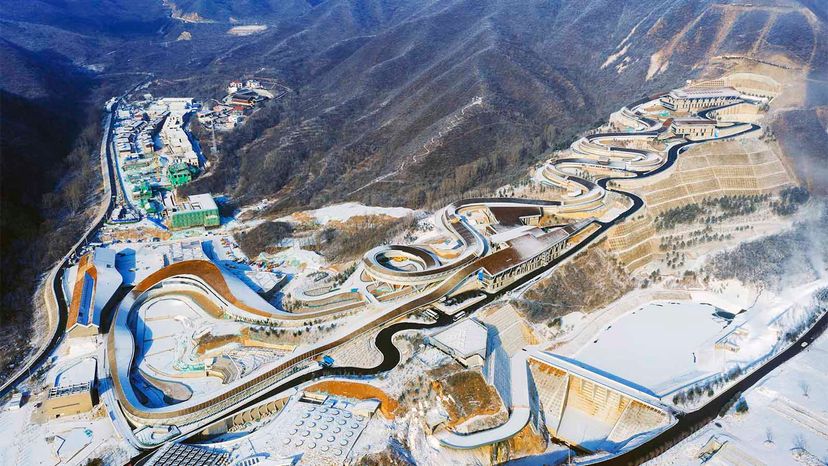Luge Track

In Olympic luge, theslider(usually not called a "luger") lies down on a fiberglass sled, with no braking system, and heads feet-first down an icy track.
There are actually two types of luge: natural track and artificial track.
Advertisement
- Innatural-track luge(naturbahn), the track is made of packed snow and ice. The slope on a natural luge track is no greater than 1.5 percent (about 1 degree), meaning that for every 100 feet (30 meters) of track, the maximum elevation change is 1.5 feet (45 centimeters). Speeds can reach up to 50 miles per hour (80 kilometers per hour). Anyone can make a natural luge track if they have enough snow.
- Inartificial-track luge(kunstbahn), the track is steeper and has high-banked turns, with an average slope of 8 to 11 percent (about 5 to 6 degrees). Speeds on an artificial track can reach 90 miles per hour (140 kilometers per hour) or even more. Austrian sliderManuel Pfisterholds the world record for fastest luge speed at 95 miles per hour (154 kilometers per hour).
Olympic luge iskunstbahn, and it's not for the meek. Two weeks before the start of the 1964 Innsbruck Games, a slider from the British luge team died on the luge track during a practice run. Crashing at 90 miles per hour (145 kilometers per hour) on an icy track can be very ugly, and luge athletes often face serious injuries if they come off the sled. In 2010, GeorgianNodar Kumaritashvilidied while training for the Vancouver Olympics when he lost control of his sled. He flew off the track and into a metal pole. The types of artificial luge tracks used in the Olympics are tremendous structures that embody a lot of technology. There are fewer than two dozen artificial luge tracks in the world.
An Olympic track is artificially refrigerated. The course is usually a reinforced concrete track with evaporators buried in the concrete. Theevaporatorscool the track to 12 degrees Fahrenheit (-11 degrees Celsius). The track is then sprayed with water to create the approximate 2-inch (5-centimeter) surface ofice.
A typical luge course is less than 1 mile (1.6 km) long and drops about 300 to 400 feet (90 to 120 meters) or 30 stories over a one-minute run. The configuration includes straightaways, left and right turns, downhills (and sometimes a short uphill) and at least one S-type curve combination like the "labyrinth," which consists of three or four consecutive turns with no straightaways between them.
The track built in Yanqing for all sliding events — bobsled, luge and skeleton — at the 2022 Winter Olympics in Beijing, is 5,298 feet long (1,615 meters) with a maximum grade of 16 percent. It features 16 curves (turns) including the world'sfirst 360-degreeKreiselturn("kreisel" is the loose German translation for "circle").
The men's singles course is 0.84 miles (approximately 1,352 meters.) while the women's singles and doubles course is 0.75 miles long (approximately 1,207 meters).
Just staying on the sled is a feat for a highly trained athlete. But sliders don't just have to stay on the sled — they also need to maintain a strictly aerodynamic form, watch where they're going and try to keep the sled in the "sweet spot" that will carry them smoothly between turns, all while facing up to 6 Gs on particularly strenuous courses.
"The craziest part about going down is the G-force you're hitting in some of these tight corners," Canadian sliderReid Watts told the CBCin 2018. "It's a real flow state." Watts first tried luge when he was just 9 years old and will be representing Canada in Beijing in 2022.
For the level of danger sliders face on each run, the amount of protective gear they wear is shockingly sparse. In the next section, we'll examine the equipment of luge.


